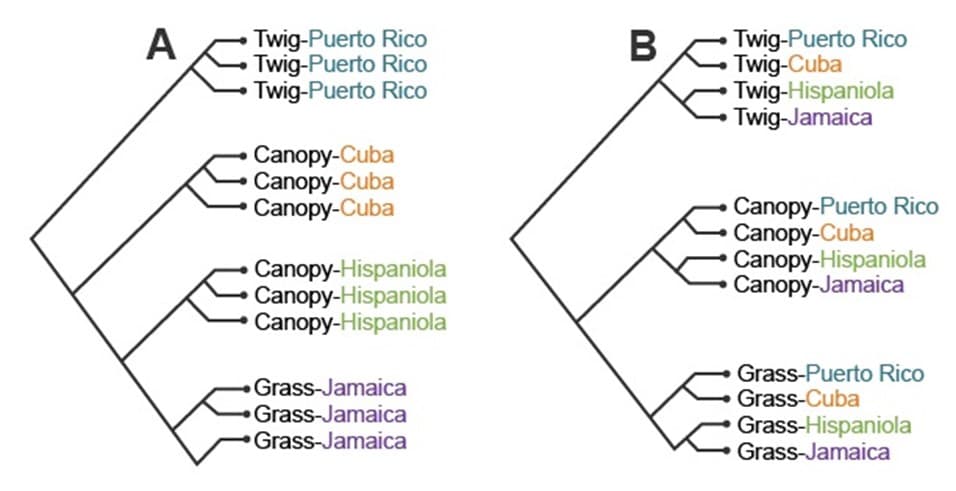Four Caribbean islands with similar environmental conditions have three different species of anole lizards with specific ecological morphotypes. Lizards Morphotypes Grass lizards Long tails Canopy lizards Large toe pads Twig lizards Short legs Researchers devised two phylogenetic trees to represent two different hypotheses about how the lizards may have evolved. The first hypothesis is that the different body types evolved repeatedly and independently of each island. The second suggests that each morphotype evolved once and spread to different islands. Which of the following statements best explains which type of data the researchers should use to test these two hypotheses, and which phylogenetic tree correctly shows the evolutionary relationships among anoles? Analyzing DNA samples from the anoles would likely show that phylogenetic tree B is correct since it is likely that each body type evolved once and spread to different islands. Analyzing the body structures of the anoles would likely show that phylogenetic tree B is correct since it is unlikely that each body type evolved similarly under the different environmental conditions on each island. Analyzing DNA samples from the anoles would likely show that phylogenetic tree A is correct since lizards located on the same island are likely to be more closely related to each other than to those on other islands because the anoles adapted to ecological niches on their island. Analyzing the body structures of the anoles would likely show that phylogenetic tree A is correct since each island has similar environmental conditions and, therefore, one would expect anoles located on the same island to be more closely related to each other than to those on different islands.
Evolution
The history and science of origin and evolution comprise two events, the beginning of life and expansion of life. Our earth originated about 4.5 billion years ago. The term evolution is derived from two Latin words and means the act of unfolding or unrolling. English philosopher Herbert Spencer first used it. Evolution is defined as the change in heritable traits of biological populations over successive generations. These traits are the manifestations of genes that are passed down from parent to offspring during reproduction.
Cladistics
Cladistics is a technique in the classification of organisms, where they are grouped into different clades. The proof for the relationships that are hypothesized is based on the shared derived characteristics known as synapomorphies. These characteristics do not exist in many of the distant ancestors and groups. The common ancestor along with its descendants is considered to be a part of the clade. The rate of closeness is directly proportional to the cladistic grouping and is useful in analyzing the evolutionary mechanism.
Outgroups
Outgroups are significant in studying cladistics or phylogenetics (that describe the evolutionary relationship between different organisms). Further, it is also important to understand the differences and similarities between different organisms.
Taxonomy
It is the branch of biology that works with the identification of organisms at first, then naming, and classification of them into phenetic or phylogenetic groups (a classification system). In other words, it is the scientific study of biological diversity and a part of systematic biology.
Phylogenetics
Phylogenetics is the scientific study of how various groups of organisms are related at the evolutionary level. It finds the relationship between various organisms based on their evolutionary similarities and differences. It is a part of the taxonomy. Although the taxonomic study is not only concerned about phylogeny but taxonomic studies are also concerned about the classification and nomenclature of the different individuals from different taxon.
Four Caribbean islands with similar environmental conditions have three different species of anole lizards with specific ecological morphotypes.
|
Lizards |
Morphotypes |
|
Grass lizards |
Long tails |
|
Canopy lizards |
Large toe pads |
|
Twig lizards |
Short legs |
Researchers devised two phylogenetic trees to represent two different hypotheses about how the lizards may have evolved. The first hypothesis is that the different body types evolved repeatedly and independently of each island. The second suggests that each morphotype evolved once and spread to different islands.
Which of the following statements best explains which type of data the researchers should use to test these two hypotheses, and which phylogenetic tree correctly shows the evolutionary relationships among anoles?

Trending now
This is a popular solution!
Step by step
Solved in 2 steps




